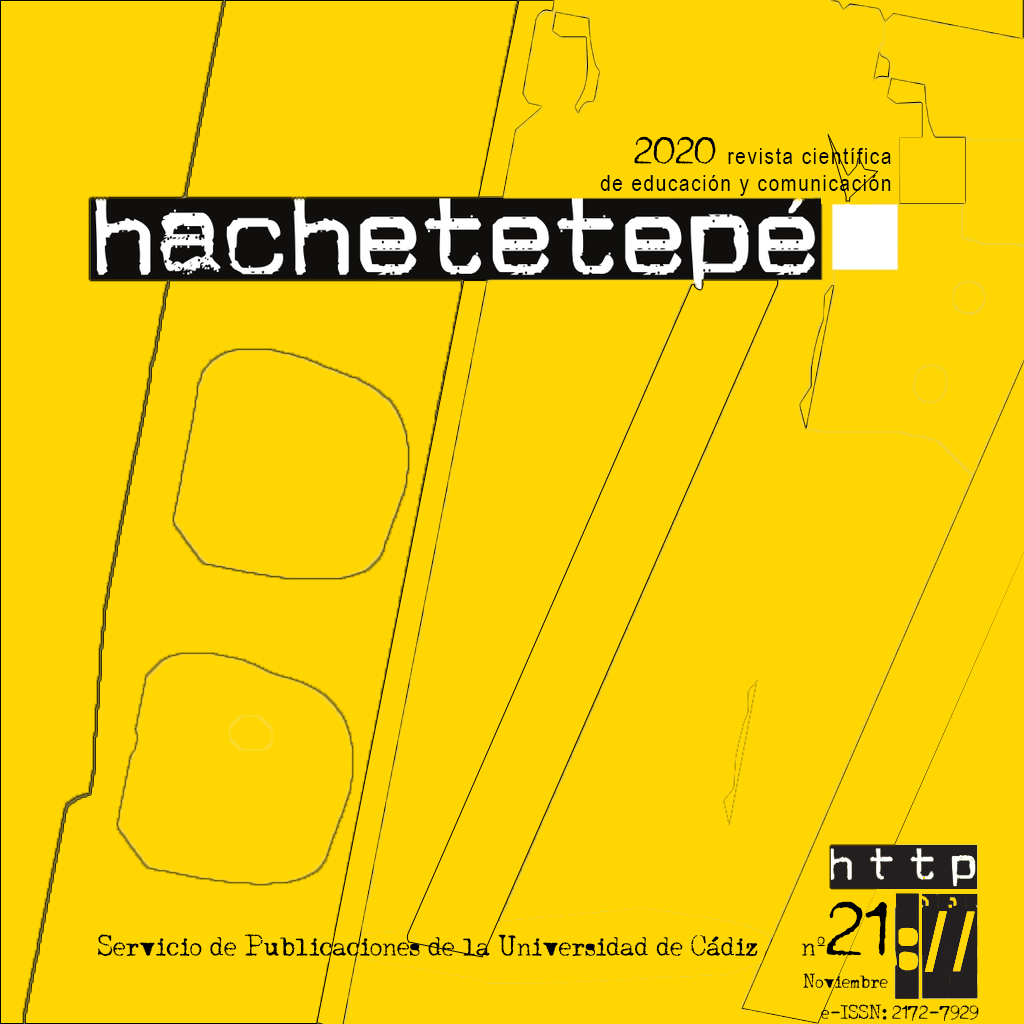Epistolary communication as a plot in the stories of the seventh art

Downloads
DOI
https://doi.org/10.25267/Hachetetepe.2020.i21.4Info
Abstract
Paper letters become faithful confidants of the protagonists in the cinema, being in certain arguments valuable sources of information. The study analyzes some films that have used letter communication in their stories and reflects on the educational and emotional value they bring. An extensive selection is made through the Internet Movie Date Base (IMDb) database of films involving letters. An analysis of the set of signs transmitting messages emitted through audiovisual discourse is developed. And reference is made to the methodological procedure used for a film from the theories on the filmic narrative and the semiotics of the story. This proposal is aimed at the educational field as it is increasingly detected that writing through technological devices generates difficulties in the processes of text composition and many spelling errors, including abbreviating words or not putting accents. Neuroeducation studies indicate that the mental representation of the letter trace (sensory-motor) helps to remember information better by activating more brain areas, something that is not achieved by typing.
Keywords
Downloads
How to Cite
License
Copyright (c) 2020 Víctor Grande-López

This work is licensed under a Creative Commons Attribution-NonCommercial-NoDerivatives 4.0 International License.
Those authors who have published with this journal, accept the following terms:
- They will retain their copyright and guarantee the journal the right to first publication of their work, which will simultaneously be subject to the Creative Commons Attribution License . They may be copied, used, disseminated, transmitted and publicly displayed, provided that the authorship, url, and magazine are cited, and are not used for commercial purposes. No derivative works are allowed.
- They may adopt other non-exclusive license agreements for the distribution of the published version of the work (e.g., deposit it in an institutional telematic archive or publish it in a monographic volume) provided that the initial publication in this journal is indicated.
- Disseminate your work through the Internet (e.g., in institutional telematic archives or on your website) once the manuscript is accepted, which may lead to interesting exchanges and increased citations of the published work. (See The effect of open access).
Hachetetepé. Scientific journal of education and communication does not charge a fee for the submission of manuscripts or for the publication of its articles.
References
Agudelo Gómez, L., Pulgarín Posada, L. y Tabares Gil, C. (2017). La estimulación sensorial en el desarrollo cognitivo de la Primera Infancia. Revista Fuentes, 19, 73-83. http://doi.org/10.12795/revistafuentes. 2017.19.1.04
Alonso Tapia, J. (2005). Motivar en la escuela, motivar en la familia. Madrid: Ediciones Morata.
Asenjo, I. (2019). La digitalización del correo: de las cartas al Whatsapp. Tecnología Innova +. Disponible en: https://www.hoy.es/tecnologia/internet/cartas-email-digitalizacion-whatsapp-20191009105232-ntrc.html
Astudillo Alarcón, W. y Mendinueta Aguirre, C. (2008). El cine como instrumento para una mejor comprensión humana. Revista de Medicina y Cine, 4, 131-136.
Barton, D. y Nigel, H. (2000). Letter Writing as a Social Practice. John Benjamins Publishing Company.
Bordwell, D. (1985). Narration in the Fiction Film. Wisconsin: The University of Wisconsin Press.
Briz, A. (1998). El español coloquial en la conversación. Barcelona: Ariel.
Cassany, D., Luna, M. y Sanz, G. (1998). Enseñar Lengua. Barcelona: Graó.
Chión, M. (1988). Como se escribe un guión. Madrid: Cátedra.
Eco, U. (1972). La estructura ausente. Barcelona: Lumen
Freire, P. (1993). Cartas a quien pretende enseñar. Argentina: Siglo XXI
García Cerdán, A. (2017). ¿Por qué todos deberíamos escribir a mano? Renunciar al teclado beneficia tu cognición. Desafía tu mente. Disponible en: https://blog.rtve.es/mente/2017/08/escribir-a-mano-cerebro.html
Garfield, S. (2013). To the letter: A curious history of correspondence. Canongate Books.
Grande-López, V. (2019). Una mayor empatía al VIH/sida a través de la educomunicación. Revista Española de Comunicación en Salud, 10(1), 102-108. https://doi.org/10.20318/recs.2019.4577
Gutiérrez San Miguel, B. (2006). Teoría de la narración audiovisual. Madrid, Cátedra.
Hedge, T. (1988). Writing. Oxford: Oxford University Press.
Krasniqi, F. (2013). Textualidad epistolar en la era digital. Impossibilia, 6, 79-93.
Romaguera I. Ramio, J. y Alsina, H. (1985). Textos y manifiestos del cine. Barcelona: Fontamara.
Sulbarán Piñeiro, E. (2016). El análisis del film: entre la semiótica del relato y la narrativa fílmica. Opción, 31, 44-71.
Teixeira de Paula, E., Mara da Silva, S. y Rita Gomes, A. (2019). Yo quiero escribir de puño y letra: Cartas de un niño con cáncer sobre el trabajo en educación social en salud. Hachetetepé. Revista en educación y comunicación, 19, 25-34. https://doi.org/10.25267/Hachetetepe.2019.v2.i19.4
Trujillo Sáez, F. (2002). Los modelos textuales en la enseñanza de la escritura y la lectura. Euphoros, 4, 11-22.
Vázquez, C. (2019a). ¿Que perdimos al dejar de escribir cartas de papel? Letras Libres. Disponible en: https://www.letraslibres.com/mexico/cultura/que-perdimos-al-dejar-escribir-cartas-papel
Vázquez, C. (2019b). Cartas de guerra el más dramático de los géneros. Letras Libres. Disponible en: https://www.letraslibres.com/mexico/cultura/cartas-guerra-el-mas-dramatico-los-generos
Yamila, D. (2014). Aprender y enseñar a través de imágenes. Desafío educativo. Revista de investigación Arte y sociedad, 6, 1-9.






